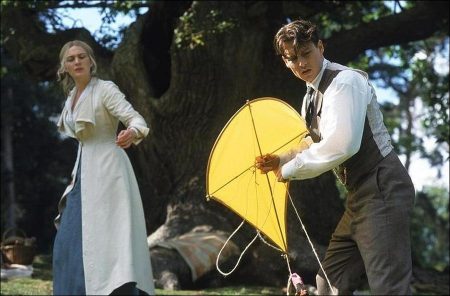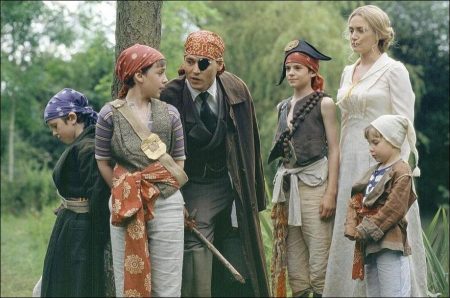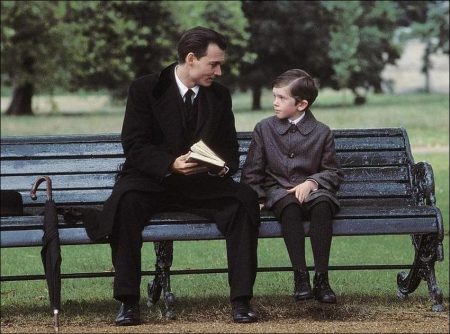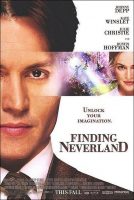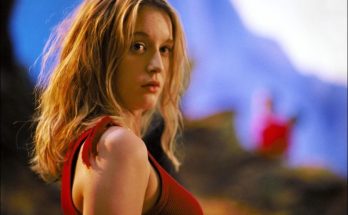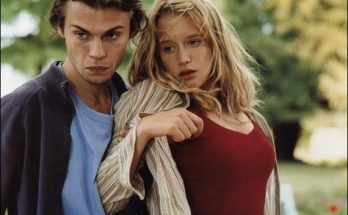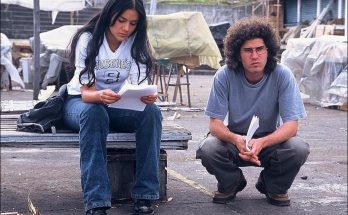Tagline: Unlock Your Imagination.
Finding Neverland movie storyline. 1903 London. Renowned playwright J.M. Barrie (James)’s latest effort has garnered less than positive reviews, something he knew would be the case even before the play’s mounting. This failure places pressure on James to write another play quickly as impresario Charles Frohman needs another to replace the failure to keep his theater viable.
Out for a walk with his dog in part to let his creative juices flow, James stumbles upon the Llewelyn Davies family: recently widowed Sylvia Llewelyn Davies (the daughter of now deceased author George L. Du Maurier) and her four adolescent sons. James and the family members become friends, largely based on he and the boys being able to foster in each other the imagination of children, James just being the biggest among them in this regard.
Sylvia also welcomes James into their lives, he who becomes an important and integral part of it. Among the six of them, the only one who does not want to partake is Sylvia’s third, Peter Llewelyn Davies, who is still grieving the reality of their lives, where his father was there one day planning an outing for the family, and gone the next. Two other people who don’t appreciate James in the Llewelyn Davies’ lives are: his wife, Mary Barrie, who always feels the need to be the responsible one in their relationship and who feels threatened by his friendship with an unmarried woman; and Emma du Maurier, Sylvia’s overbearing mother, who sees him as an obstacle to Sylvia moving on with her life with another potential husband, and an impediment to maintaining discipline within the boys.
James still hopes to bring Peter out of his self-imposed shell, but in the process comes up with an idea for another play based on an amalgam of himself and Peter, that play which eventually becomes what Charles sees as a largely unmountable and thus doomed production called “Peter Pan”. This process of helping Peter could take a step backward when it looks like Sylvia may imminently befall a similar fate to that of her late husband.
Finding Neverland, a British-American historical fantasy drama film released in 2004, is about playwright J. M. Barrie and his relationship with a family who inspired him to create Peter Pan, directed by Marc Forster. The screenplay by David Magee is based on the play The Man Who Was Peter Pan by Allan Knee. The film was budgeted at $25 million. It grossed $51,676,606 in the US and $63 million in foreign markets for a total worldwide box office of $115,036,108.
About the Production
Director Marc Forster’s follow-up to “Monster’s Ball” is “Finding Neverland,” a tale of magic and fantasy inspired by the life of James Barrie, the real-life author of the children’s classic Peter Pan.
Set in London in 1904, the film follows Barrie’s creative journey to bring Peter Pan to life, from his first inspiration for the story up until the play’s premiere at the Duke of York’s Theatre – a night that will change not only Barrie’s own life, but the lives of everyone close to him. The imagination of the man behind “Peter Pan” combine in this emotional tale inspired by events in the life of Scottish author James Mathew Barrie.
In Finding Neverland, director Marc Forster (“Monster’s Ball”) and an accomplished cast including Johnny Depp, Kate Winslet, Dustin Hoffman and Julie Christie take a fictional look at the creation of “Peter Pan,” the classic of children’s literature that speaks directly to the child in all of us.
Finding Neverland traverses both fantasy and everyday reality, melding the difficulties and heartbreak of adult life with the spellbinding allure and childlike innocence of the boy who never grows up.
It all begins as successful Scottish playwright J.M. Barrie (Johnny Depp) watches his latest play open to a ho-hum reaction among the polite society of Edwardian England.
A literary genius of his times but bored by the same old themes, Barrie is clearly in need of some serious inspiration. Unexpectedly, he finds it one day during his daily walk with his St. Bernard Porthos in London’s Kensington Gardens. There, Barrie encounters the Llewelyn Davies family: four fatherless boys and their beautiful, recently widowed mother (Kate Winslet).
Despite the disapproval of the boys’ steely grandmother Emma du Maurier (Julie Christie) and the resentment of his own wife (Radha Mitchell), Barrie befriends the family, engaging the boys in tricks, disguises, games and sheer mischief, creating play-worlds of castles and kings, cowboys and Indians, pirates and castaways. He transforms hillsides into galleon ships, sticks into mighty swords, kites into enchanted fairies and the Llewelyn Davies boys into “The Lost Boys of Neverland.”
From the sheer thrills and adventurousness of childhood will come Barrie’s most daring and renowned masterwork, “Peter Pan.” At first, his theatrical company is skeptical. While his loyal producer Charles Frohman (Dustin Hoffman) worries he’ll lose his shirt on this children’s fantasy, Barrie begins rehearsals only to shock his actors with such unprecedented requests as asking them to fly across the stage, talk to fairies made out of light and don dog and crocodile costumes.
Then, just as Barrie is ready to introduce the world to “Peter Pan,” a tragic twist of fate will make the writer and those he loves most understand just what it means to really believe.
About “Finding Neverland”
Director Marc Forster was looking for something magical when Academy Award nominated producer Richard Gladstein brought him David Magee’s screenplay for Finding Neverland. Forster was immediately drawn to the story, which imagined the circumstances and emotions behind the creation and evolution of “Peter Pan,” a tale that has touched millions all over the world.
Inspired by J.M. Barrie’s real-life friendship with the Llewelyn Davies family, Finding Neverland is infused with the same themes that make Barrie’s play of “Peter Pan” so resonant: the wonder of the imagination, the nostalgia for childhood innocence and the longing to believe in something more enchanted than everyday life.
“I saw the film as a story about the power of a man’s creativity to take people to another world, and about the deep human need for illusions, dreams and beliefs that inspire us even in the face of tragedy,” comments Forster. “For me, it is about the transformative power of imagination — being able to transform yourself into something greater than you are, even if nobody believes in you.”
For Richard Gladstein, Finding Neverland presented “a unique opportunity to create a film combining intimate personal and emotional drama with incredible bursts of imagination and invention.” He adds: “It’s a story for the child and adult in all of us.”
David Magee’s screenplay for Finding Neverland was adapted from award-winning playwright Allan Knee’s stage play “The Man Who Was Peter Pan,” an imaginary series of conversations between Barrie and the Llewelyn Davies boys. Producer Nellie Bellflower had seen the play at a local theater workshop and immediately optioned it, bringing it to Magee.
Notes Bellflower, “Allan Knee’s play was an incredibly moving story of a man who becomes a father figure to these young boys and then guides them through terrible tragedy. I had always loved ‘Peter Pan’ and Allan’s play was a fantastic jumping-off point for exploring the creation of ‘Peter Pan’ and its universal themes.”
Notes Magee: “The screenplay I wrote is not a factual retelling of what happened to James Barrie when he wrote Peter Pan. I wanted to tell a story about what it means to grow up and become responsible for those around you. I hope people see the film as a respectful tribute to Barrie’s creative genius and come away with a feeling that as human beings, we can grow up without losing all aspects of childhood innocence and wonder.”
Magee also found that the story became ever more emotional and personal as he wrote. “My first child was about to be born when I started working on this material, and my father was coming to the end of his life after a long battle with cancer, so I was really thinking intensely about what it means to grow up and to become aware that time really is chasing after all of us,” he explains. “For me, this story is about a man who is starting to face these issues in his own life.”
Magee continues: “As a writer, I was also interested in exploring how one’s own life inspires art and how art in turn informs our lives. There is this notion that creative people hold onto their childhoods longer than the rest of us, but there are moments throughout our lives that weigh on us heavily that we need to explore through storytelling and art. Barrie’s brilliance in ‘Peter Pan’ is that he expressed both the joy in childhood and just how bittersweet it is when you have to leave it behind. He took this very real and universal experience and made it something magnificent and special.”
At the suggestion of then Miramax executive, Michelle Sy, Nellie Bellflower sent a draft of the screenplay to producer Richard Gladstein. At this point, Sy contacted Gladstein and the project was set up at Miramax. The screenplay was developed and the search for the right director began. The search took a fateful turn when Gladstein saw an early screening of Marc Forster’s award-winning “Monster’s Ball,” which told a harrowing love story between a prison guard and a criminal’s widow with tenderness and raw emotion. Says Gladstein, “The depth of character and subtlety in all the performances convinced me that Marc would bring something unique and special to the project.”
As they developed the screenplay and began to search for a cast, Gladstein notes that the filmmakers found inspiration in some of Barrie’s own words. “Barrie wrote an important bit of direction to his actors, saying ‘All characters, whether grown-ups or babes must wear a child’s outlook as their only important adornment.’ This principal guided us in the creation of the film,” says Gladstein, “and we even wrote it, as a sort of prologue, into several drafts of the screenplay so that all the actors and crew understood the intention.”
Central to Finding Neverland is Johnny Depp, the recent Golden Globe nominee and Oscar nominee, who as much as any leading modern actor, seems to have kept his own childlike spirit vibrantly alive. Says Marc Forster of Depp: “Johnny is perfect to represent a man who never wants to grow up because you can see that he has this very accessible child inside him from the choices of movie roles he makes. He brought something very special to the role, underplaying it in a way that really pays homage to the man we both believe Barrie wanted to be.”
Depp also found his way into his role by working with a voice coach on an authentic Scottish brogue, which he employs with the quiet air of a man who on some levels will always remain an enigma. “Johnny brings out a natural sense of mystery in his portrayal of Barrie, sparking the audience’s curiosity about what’s happening in Barrie’s mind,” notes Richard Gladstein.
Depp particularly enjoyed how the story of Finding Neverland is propelled by the undercurrent of unspoken love between his character and Kate Winslet’s – a love that never becomes a typical romance. “The film never seems to go quite where you expect it go,” he says. “It never turns into a sentimental love story of two people destined to be together or that sort of thing. Instead, it’s a much more complicated and moving relationship between two people who need each other on a level that’s really beyond explanation or words.”
Most of all, though, Depp was drawn to the role by the magic of the “Peter Pan” story itself. “It’s truly a work of genius,” he says. “It’s a masterpiece of imagination, and the result of the most remarkable inspiration. It’s one of those rare perfect things in the world that will always be with us and this was a wonderful opportunity to explore where such a powerful story might have come from.”
For Kate Winslet, working with Johnny Depp really drove home the film’s idea that anyone can tap into the spontaneity and adventure of being a child again. “Johnny was so able to be a child on the set that it was sort of like working with five children for me! He made me and the boys constantly laugh with his cleverness which is exactly what we needed to create the spirit of the story.”
Winslet, a three-time Oscar nominee (for “Sense and Sensibility,” “Titanic” and “Iris”) is no stranger to “Peter Pan” territory. She played Wendy in a theater production when she was just 15 years old and has always been intrigued by the fantastical universe of Neverland. When she read the script for Finding Neverland it was Sylvia du Maurier, the fiery bohemian mother of a brood of charming young boys in a time of great formality, who captured her fascination.
“The character of Sylvia is such an interesting person,” she notes, “because she’s a very modern mother in an era when the view of children was just starting to change. Most people still believed children should be seen and not heard, and children were typically kept away from the adult life in the household. Sylvia does things differently, and she reflects a change in how children were raised. She’s very involved in her children’s upbringing and she encourages them to be free spirits. I love the fact that she’s such a nonconformist.”
Winslet continues: “But Sylvia is also a recent widow, so there’s a lot of buried grief and anger in her, and I think that’s part of what makes James M. Barrie so intriguing to her. He’s this larger-than-life character who couldn’t be more different from most of the men she meets in her social circle. She’s really magnetically drawn to this man, not because he seduces her, but because he welcomes her into his incredible fantasy world. I do believe at the end of the day, this is a love story, but it’s about the love between Barrie and a whole family.”
Though there aren’t volumes written about Sylvia du Maurier’s life, as there are with Barrie, some of the real Sylvia’s letters and writings have survived. Winslet was moved to learn that one aspect of her story that is entirely true is that she made the decision not to be treated for her cancer. Sylvia wanted to protect her sons by shielding them from her debilitating health and keep them from seeing her suffer through drawn out and painful treatments. “I think it was the most extraordinary act of bravery,” says Winslet. “She wanted life to continue as normal and she wanted to slip away quietly. It’s an amazing sacrifice to have made for her children.”
For Marc Forster, Winslet was a revelation in the role. “She’s a mother herself so she has this wonderful ability with the kids to embrace them and yet also be very down-to-earth. There’s a real physicality to her as a mother that was very important to me; especially because when she ultimately passes, you really feel the children’s immense sense of loss.”
Another character who plays a unique role in Barrie’s creation of “Peter Pan” is that of Charles Frohman, the wealthy American impresario who stood by Barrie through much of his career, and finds himself backing an entirely unconventional fantasy play he fears will be a failure. The real Charles Frohman – known as “the Napoleon of drama” — was famed for his ability to develop new talent and was associated not only with Barrie but with such major writers as Oscar Wilde and W. Somerset Maugham. He was also noted for bringing to the fore such Broadway stars as John Drew, Ethel Barrymore, E.H. Sothern, Julia Marlowe, Maude Adams, and Henry Miller. (Tragically, Frohman died at the height of his career when the ocean-liner Lusitania was sunk by a German submarine. Echoing “Peter Pan,” his final words were reported to be “Why fear death? It is the most beautiful adventure in life.”)
Academy Award-winner Dustin Hoffman took on the role of Frohman in part so he could work with both Forster and Depp. “I saw ‘Monsters Ball’ and have wanted to work with Marc Forster ever since. I also knew that James Barrie was going to be played by Johnny Depp and I think he’s one of our greatest young actors. He has a quality that I highly admire – he tries everything in his power not to be a star. He takes chances on the roles he chooses and eludes being a pin-up, despite being so handsome.”
Hoffman was also intrigued by Frohman’s profound commitment to making an artist’s dreams come true, no matter how risky. “What interested me about Frohman is that he’s quite hesitant and reluctant to produce ‘Peter Pan,’ a play with fairies, pirates and crocodiles that he can’t imagine will be accepted by sophisticated London theater-goers. Yet Frohman was the rarefied producer who had the ability to sense genius and who understood that, by definition, genius is excelling at doing something that hasn’t been done yet, something in which the artist goes out on a limb. He let Barrie take a risk, and it paid off for the whole world.”
One of the most demanding roles in the film is that of Barrie’s lonely wife, Mary, played by Radha Mitchell, who previously collaborated with Marc Forster on “Everything Put Together.” Mitchell found great empathy for Mary as a woman trapped in a difficult marriage. “Mary can seem cold but she’s just angst-ridden because she’s in love with a man whom she can’t connect to no matter how hard she tries,” says Mitchell. “I wanted to make her perspective more clear and really show how frustrated she is by this gulf between her and her husband. I already knew that Marc as a director is someone who never plays to stereotypes. He wants performances to be very real and naturalistic, which was a wonderful challenge with Mary.”
And then there are the four young boys with whom Barrie leaves his everyday reality for a place where fairy tales and legends come to life. From the beginning, the filmmakers knew that casting the Llewelyn Davies boys would be key. After extensive auditions, they were able to narrow the search down to a few dozen exceptional young actors. Then, instead of holding individual readings, the filmmakers had groups of boys read together in search of that certain volatile chemistry – a mix of rivalry and closeness – that occurs between real siblings.
“It was very important that the boys get on together just like a real family, since I wanted very natural performances from them,” notes Forster. “The boys we chose are all very special and gifted. Each one came to the set with a rare depth and sensitivity – as well as a sense of fun – which made telling this story so much easier.” Adds Kate Winslet: “The boys often felt like young men rather than children to me because they were so very intelligent, professional and warm — even Luke Spill, who’s six years old, was sharp as a button.”
For his part, Johnny Depp did his best to bring out the mischief hiding just beneath their professional manners. “You’d expect that these little boys would be climbing the walls on a movie set, but they had incredible concentration and focus. In fact, sometimes we had to loosen them up,” Depp explains. “For the dinner party scene, for example, Marc and I planned in advance that I could use my fart machine at certain moments. We hid the machine under the table and waited until the boys’ close-ups and then I just started nailing them, and it worked like a charm.”
Producer Richard Gladstein was particularly impressed with Freddie Highmore, who plays Peter, the ever-so-serious namesake of the boundlessly playful character he will soon inspire. “Peter is the principal child in the film and I think Freddie is pure magic, “ says Gladstein. “He was the first actor that read for Marc and I and he defined the character. We went on to see a few others but by the end of the day we knew we found our Peter. He’s created the role the way an adult actor would in a really mysterious, rich and emotional way.”
Highmore had a tremendous grasp of the story and his role inside of it. He explains: “Peter is always thinking about his father and he doesn’t think it’s right that Barrie should come in and take over. But then Barrie shows him things he didn’t know – like that he can write. Peter isn’t really like ‘Peter Pan’ because he’s ready to grow up. Actually, I think Barrie’s the child who never grew up because he was always taking the boys off and playing pirates and cowboys and stuff. No matter what he says, Barrie is the real Peter.”
All the boys – including Joe Prospero who plays Jack, and Nick Roud who plays George – had a blast with the endless make-believe, dressing-up and swash-buckling that the roles required. Sums up Prospero; “It was really fun to be in this movie. Every day we were pirates or cowboys and we got soaked and knocked over and just had a really good time.”
Bringing more fun to the cast are two hip young British comedians, Paul Whitehouse (“The Fast Show”) and Mackenzie Crook (best known to Americans as Gareth on “The Office”) as Barrie’s stage managers. Notes Richard Gladstein: “Paul Whitehouse and Mackenzie Crook are wonderfully trained comedic performers and they, along with Johnny and Dustin create a kind of light, imaginative, secure other world inside the walls of the theater, where they’re able to be wonderfully free, playful and creative.”
Finally, making a special guest appearance in the cast is Laura Duguid, J.M. Barrie’s reallife god-daughter and the daughter of Nico, the youngest of the real-lifeLlewelyn Davies boys. She plays the small but vital role of the theater-goer who at the party following “Peter Pan’s” premiere suggests that young Peter Llewelyn Davies must be the real “Peter Pan,” only to have Peter point to Barrie and reply: “But I’m not Peter Pan, he is.” Duguid was just nine years old when Barrie died. Nonetheless, she has unforgettable memories of spending time with him as a child.
Finding Neverland (2004)
Directed by: Marc Forster
Starring: Johnny Depp, Kate Winslet, Julie Christie, Radha Mitchell, Dustin Hoffman, Freddie Highmore, Kelly Macdonald, Mackenzie Crook, Eileen Essell
Screenplay by: David Magee
Production Design by: Gemma Jackson
Cinematography by: Roberto Schaefer
Film Editing by: Matt Chesse
Costume Design by: Alexandra Byrne
Set Decoration by: Trisha Edwards
Art Direction by: Peter Russell
Music by: Jan A.P. Kaczmarek
MPAA Rating: PG for mild thematic elements and brief language.
Distributed by: Miramax Films
Release Date: November 12, 2004
Views: 86
